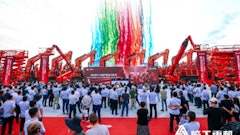The Coneqtec/Universal DCS6000 compaction plate is specifically designed to allow contractors to take advantage of existing equipment on a jobsite.
"It especially helps the small contractor who has a skid steer but not an excavator," says Andy Campbell, sales manager. "He can still get the advantages of being able to work in the trench with a compaction plate."
The hydraulic motor on the DCS6000 is powered by the skid steer, allowing the attachment to deliver more compaction force. "The hydraulic power on the skid steer is going to be greater than what you would get out of a [walk-behind] machine," Campbell asserts. "It's a little easier on the operator, of course. And it utilizes a piece of equipment that's more than likely already on the jobsite. It just makes the skid steer more valuable and pays its way."
(Video of the attachment in action can be found at the end of this article.)
Dual counterweights ensure true vertical compaction force is applied. "[This] allows for higher compaction forces to be used on smaller power units without adding to the wear and tear of rubber mounts, loader arms or the host machine," says Campbell. "It also lessens the vibrations passed on to the operator and reduces operator fatigue."
A patented extended front lip on the attachment enables the plate to back-drag any excess material for leveling before compaction takes place. This helps to ensure the bottom of the trench is kept level throughout the length of the trench.
Because the skid steer and attachment are best suited for use in shallower trenches (typically 24 to 30 in. deep), the potential for cave-ins is less of a concern. However, dust and debris are a common problem with walk-behind compactors.
"With our attachment, the operator is in the skid steer, so he's up and out of the trench and away from a lot of the dust that's created with a compaction plate," notes Campbell. "And since he's sitting up [in the cab], he has a better view of the work site... he can see ahead of him. If somebody has their back turned, he is able to see that and stop, so there is less chance of someone getting hurt. That's pretty important on a jobsite."



















